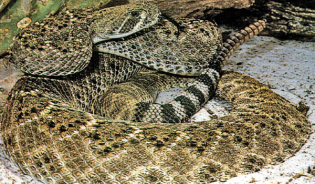We all love spring! The wildflowers. The still comfortable temperatures. The pips of baby birds. The wobbly legs of newborn fawns.
The snakes.
They may not make the typical line-up of “spring in Texas” postcards, calendars, and photo galleries, but this time is the right time for snakes as they seek out mates while also enjoying the milder days. While there is no doubt snakes play an invaluable role in our ecosystem including keeping rodent populations in check, for many of us even just writing about snakes can bring on a case of the creepy-crawlies. According to Texas Parks & Wildlife, Texas is home to over 105 different species and subspecies of snakes, but only a handful of those are potentially dangerous to humans. In fact, bees, wasps, and hornets and even cows (yes, cows) kill more people each year than snakes. Admittedly, those statistics may be of small comfort when you’ve got a case of the creepy-crawlies, but being able to identify those that can cause harm – and know you need to steer clear – can help you stay safe this sssseason.
 Rattlesnakes
Rattlesnakes
When it comes to striking fear in an audience, rattlesnakes are a moviemaker’s go-to snake. What western is complete with the jangle of spurs and the menacing shake of a rattler? In Texas, there are actually eight (or nine or ten, depending on who you ask) species of rattlesnakes, ranging from the western pygmy rattlesnake, no more than about 18 inches long, to the western diamondback rattlesnake, which can grow to 5 or 6 feet in length. But what they all have in common is found – and heard – at the tip of their tails. When born, rattlesnakes have a small “button” at the tip of their tail. As they grow, rattlesnakes shed their skin and each shed skin adds a new segment to their rattle. The most common rattlesnake in Texas is the aptly named western diamondback with its brown, diamond-shaped markings along the middle of the back. Rattlesnakes rarely bite unless threatened or provoked and, while they are famous for their rattle warnings, it is not a guarantee so stay aware of your surroundings. Take care near rocky areas and where snakes might enjoy sunning themselves. Fun fact: decapitated rattlesnake heads can still inflict venomous bites for even an hour. So, even if you see what looks like a dead rattlesnake, just steer clear. Don’t mess with Texas. Don’t mess with rattlesnakes.
 Copperheads
Copperheads
Copperhead snakes are identified by their … wait for it … copper-colored head and chestnut or reddish-brown crossbands on a lighter colored body. They are about two to three feet long and tend to favor rocky areas and wooded bottomlands and, in the spring, can be found along streams and rivers. On the bright side, copperhead venom is less potent than that of other species, and their short fangs can inject only a relatively small dose. On the less bright side, because their coloring provides terribly accurate camouflage, most copperhead bites occur when a snake is accidentally picked up or sat on. When cleaning up your property or cleaning out your shed, be sure to take care when flipping over logs, boards, old tin or other items where copperheads may be resting.
 Cottonmouths
Cottonmouths
Also known as “water moccasins” these snakes like the water and may climb into low branches at the edges of rivers or lakes. Swimmers and those fishing on river banks should always keep an eye open for these snakes. Cottonmouths average about 3.5 feet in length, but can grow to around 6 feet. They can be dark brown, olive-brown, olive green or almost solid black. They are marked with wide, dark bands, which are more distinct in some individuals than in others. Because they are more brilliantly marked, juvenile cottonmouths may even resemble copperheads. Cottonmouths are a heavy bodied snake – some may call them “chunky” but maybe don’t say so to their face. The inside of their mouth is white – hence the name. While they will typically drop into the water and happily swim away when disturbed, they can be quite defensive and aggressive. Cottonmouth venom is dangerous and can cause significant tissue destruction.
 Coral Snakes
Coral Snakes
The Texas coral snake is famously shy and rarely seen but, while rare, bites from this relative of the cobra do happen and they are poisonous. This slender snake is usually 2.5 feet or shorter and, thanks to its shiny, colorful bands of red, yellow, and black, the Texas coral snake has a rhyme to help keep you safe and distinguish it from similarly marked harmless snakes such as the milk snake.
Red on yellow, kill a fellow
Red on black, venom lack (or friend of Jack)
To avoid being bitten by any snake, wear boots or high-topped shoes, long pants and long-sleeved shirts when you’re out hiking or hunting. Use a walking stick to prod uncleared ground. Be constantly on the lookout for snakes and be careful sitting on or stepping over logs. Truth be told, snakes want to engage you even less than you want to tangle with them. More people are bitten trying to kill a snake rather than just safely moving away. But if they feel threatened, even if unintentionally so (maybe you hiked up on their sunning spot and simply never saw that rattlesnake), they may strike. To prepare yourself should that rare event happen, know what to do by taking a moment now to read Texas Parks & Wildlife’s Venomous Snake Safety.
For more on the venomous snakes of Texas, check out Venomous Vipers (Texas Parks & Wildlife Magazine, May 2015).
All photos above via the Samuel Roberts Noble Foundation’s Learn to Recognize Venomous Snakes.










One Comment